2019 MERCEDES-BENZ CLA COUPE child restraint
[x] Cancel search: child restraintPage 9 of 330

Roof
lining ...................................... 272
Se at belt ........................................ 271
Seat cover .....................................2 71
Sensors ......................................... 269
Steering wheel....... ........................271
Trim pieces ....... .............................271
Was hing byhand ........................... 266
Whee ls....... ....................................268
Windo ws....... ................................. 268
Wip erbla des ....... ........................... 269
Wood entrim .................................. 271
Cargo compartm entenlargemen t... 242
Cargo tiedow nrings .........................243
CD
see also Digita lOpera tor'sMan-
ua l....... ...........................................231
CD player (on-bo ardcomputer) ........185
Ce nter conso le
Lowe rsection .................................. 36
Uppe rsection .................................. 35
Ce ntral locking
Automa ticlocking (on-boardcom-
pute r)....... ......................................189
Locking/u nlocking(SmartKe y)....... .70
Cha nge ofaddress .............................. 26
Cha nge ofowner ship.......................... 26
Cha nging awheel
Wheel sand tires ............................ 311
Child
Rest raintsyst em.............................. 56
Child seat
For ward- facing restraint system...... 59
LA TCH- type (ISOF IX) child seat
anc hors............................................ 57
On thefron t-passe nger seat ............ 58
Rearwar d-facin gres traint system.... 59
Top Tether ...................................... .5 7
Child -proof locks
Imp ortant safe tyno tes.................... 59
Rear doors.......................................6 0
Child ren
Spe cial seat beltretrac tor...............5 5
Child reninthevehi cle
Imp ortant safe tyno tes.................... 54
Cigar ettelight er................................ 247
Cleani ng
Mirr ortur nsign al...........................2 69 Cl
imate control
Air-conditi oningsystem .................112
Automa ticclima tecontrol (dual-
zone) ..............................................114
Control lingautomatica lly....... ........117
Coo ling with airdehu midificati on.. 116
Defrosting thewindows .................119
Defrosting thewindshi eld....... ....... 118
Gene ralnotes ................................ 111
Indica torlamp ....... .........................117
Informati onabo utusi ng auto-
matic climatecontrol ..................... 115
Maxi mum cooling....... ................... 119
Notes onusing the air-conditio n-
ing system .....................................113
Overvi ewofsys tems ......................111
Prob lemwith the rear window
defro ster........................................ 120
Prob lems with cooli ngwith air
dehu midificati on....... ..................... 117
Ref rige rant .....................................324
Ref rige rant filling capa city....... ...... 324
Setting theairdis tribu tion............. 117
Setting theairvents ......................121
Setting theairflow ......................... 118
Setting thetempera ture................117
Switchi ngair-recircu lation mode
on/off ............................................120
Switchi ngon/off ........................... 116
Switchi ngresi dua lhea ton/off ......120
Switchi ngthe rear window
defro steron/off ............................ 119
Switchi ngthe ZONE function
on/off ............................................118
Co ckpit
Overvi ew....... ................................... 32
see Instrument cluster
COMA NDdisplay
Cl eani ng....... .................................. 270
Co mbinati onswi tch ....... ................... 102
Co mpass
Ca librating .....................................258
Ca lling up ....... ................................258
Mag netic fieldzone maps....... ....... 258
Setting ...........................................258
Co nne ctin gaUSB device
see also Digita lOpera tor'sMan-
ua l....... ...........................................231 In
dex
7
Page 42 of 330
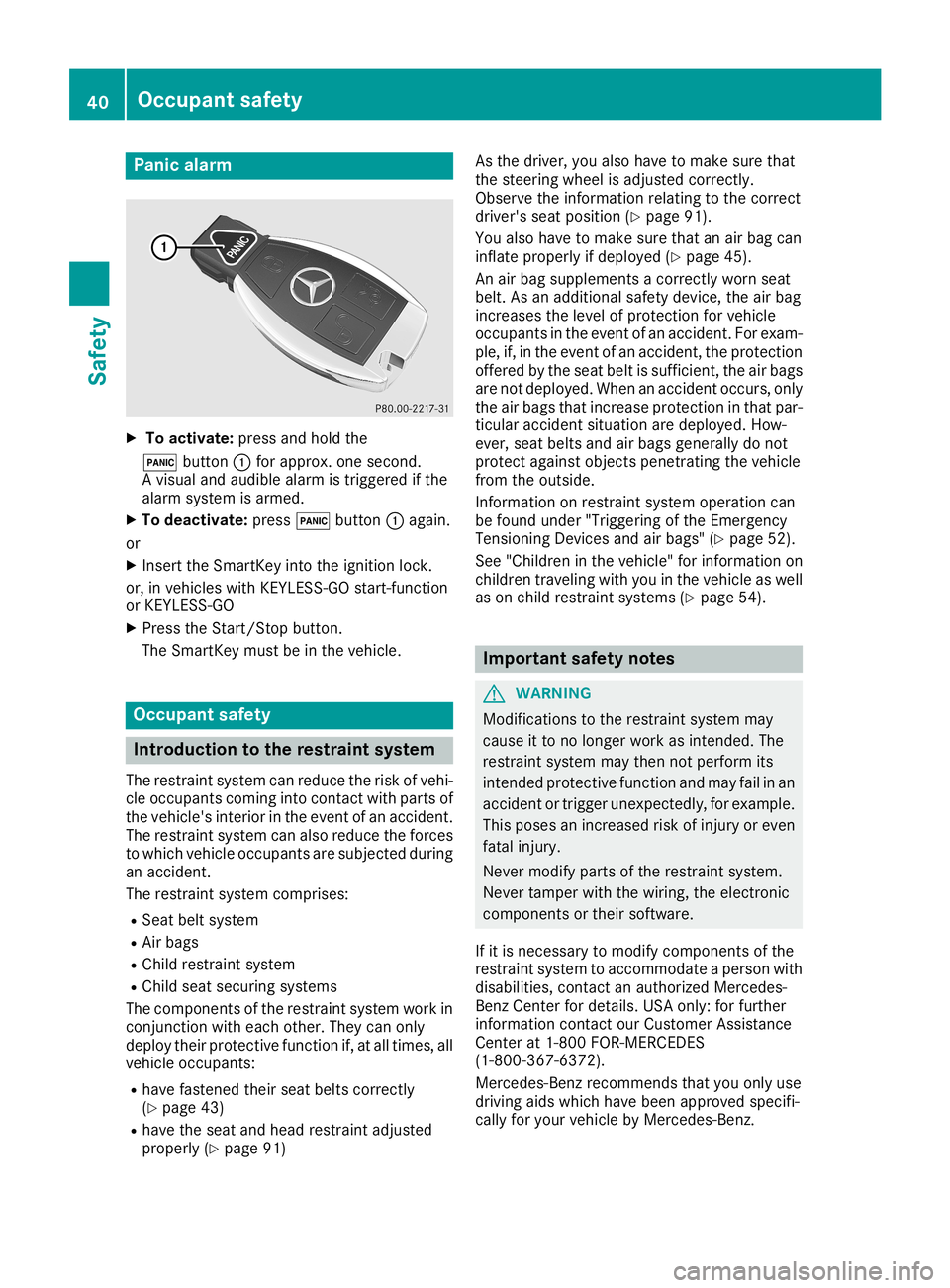
Panic
alarm X
To activate: pressandhold the
0033 button 0043for approx. onesecond.
A visual andaudib lealarm istriggered ifthe
alarm system isarmed.
X To deactivat e:press 0033button 0043again.
or X Insert theSmartK eyinto theignition lock.
or, invehicles withKEYLE SS-GO start- function
or KEYLE SS‑GO
X Press theStart /Stopbutton.
The SmartK eymust beinthe vehicle. Occupant
safety Introduct
iontothe restr aintsystem
The restraint systemcanreduce therisk ofvehi-
cle occupants comingintocont actwith parts of
the vehicle's interiorinthe event ofan accident.
The restraint systemcanalso reduce theforces
to which vehicle occupants aresubjected during
an accident.
The restraint systemcomprises:
R Seat beltsystem
R Air bags
R Child restraint system
R Child seatsecuring systems
The componen tsof the restraint systemworkin
conj unction witheach other. Theycanonly
deploy theirprotect ivefunct ionif,at all times, all
vehicle occupants:
R have fastened theirseatbelts correct ly
(Y page 43)
R have theseat andhead restraint adjusted
properly (Ypage 91) As
the driver, youalso have tomake surethat
the steering wheelisadjusted correctly.
Observe theinformation relatingtothe correct
driver's seatposition (Ypage 91).
You also have tomake surethatanair bag can
inflate properly ifdeploye d(Y page 45).
An airbag supplements acorrect lyworn seat
belt. Asanadditional safetydevice, theairbag
increases thelevel ofprotect ionforvehicle
occupants inthe event ofan accident. Forexam-
ple, if,inthe event ofan accident, theprotect ion
offered bythe seat beltissufficient, theairbags
are not deploye d.When anaccident occurs,only
the airbags thatincrease protectioninthat par-
ticular accident situation aredeploye d.How-
ever, seatbelts andairbags generally donot
protect againstobjectspenetrat ingthe vehicle
from theoutside.
Inform ationonrestraint systemoperation can
be found under "Triggering ofthe Emergen cy
Tensioning Devicesandairbags" (Ypage 52).
See "Chil dren inthe vehicle" forinformation on
children traveling withyouinthe vehicle aswell
as on child restraint systems(Ypage 54). Import
antsafety notes G
WARNING
Modifications tothe restraint systemmay
cause itto no longer workasinten ded.The
restraint systemmaythen notperform its
inten dedprotect ivefunct ionand may failinan
accident ortrigger unexpect edly,forexample.
This poses anincreased riskofinjury oreven
fatal injury.
Never modify partsofthe restraint system.
Never tamper withthewiring, theelectron ic
componen tsor their software.
If it is necessary tomodify componen tsof the
restraint systemtoaccommodate aperson with
disabil ities,contactanauthorized Mercedes-
Benz Center fordetails. USAonly: forfurther
information contactour Customer Assistance
Center at1-80 0FOR-MERCED ES
(1‑800‑367‑6372 ).
Mercedes-B enzrecommen dsthat youonly use
driving aidswhich havebeen approved specifi-
cally foryour vehicle byMercedes-B enz. 40
Occ
upantsafetySafety
Page 44 of 330

occupant
inthe best position inrelation tothe
air bag.
The seat beltsystem comprises:
R Seat belts
R Emergen cyTensionin gDevices forthe front
seat belts andtheouter seatbelts inthe rear
R Seat beltforce limiters forthe front seatbelts
and theouter seatbelts inthe rear
If the seat beltispulled outofthe belt outlet
quickly orwith ajerk ymovement ,the belt
retract orlocks. Thebelt strap cannotbe extr ac-
ted any further.
The Emergen cyTensionin gDevice tightensthe
seat beltinan accident ,pulling thebelt close
against thebody. However itdoes notpull the
vehicle occupant backinthe direction ofthe
backrest .
The Emergen cyTensionin gDevice doesnotcor-
rect anincorr ectseat position orthe routing of
an incorr ectlyfastened seatbelt.
When triggered, aseat beltforce limiter helpsto
reduce theforce exertedbythe seat beltonthe
vehicle occupant .
The seat beltforce limiters forthe front seats are
synchron izedwith thefront airbags, which
absorb partofthe deceleration force.Thiscan
reduce theforce exertedon the vehicle occu-
pants during anaccident .
! If
the front -passenger seatisnot occupied,
do not engage theseat belttongue inthe
buckle onthe front -passenger seat.Other-
wise, inthe event ofan accident theEmer-
gency Tensionin gDevice andtheside impact
air bag, inaddition toother systems, maybe
triggered andhave tobe replaced.
Import antsafety notes The
useofseat belts andchild restraint systems
is required bylaw in:
R all 50 states
R the U.S. territ ories
R the Distr ictofColumbia
R all Canadian provinces
Even where thisisnot required bylaw, allvehicle
occupant sshould correctlyfasten theirseat
belts before startingthe journey. G
WARNING
If the seat beltisnot worn correc tly,itcann ot
perform itsinten dedprotect ivefunct ion.An incorr
ectlyfastened seatbeltcanalso cause
injuries, forexample, inthe event ofan acci-
dent orwhen braking orchanging direction
abruptly. Thisposes anincreased riskofinjury
or even fatalinjury.
Always ensurethatallvehicle occupant shave
their seatbelts fastened correctlyand aresit-
ting properly.
The componen tsof the restraint systemworkin
conj unct ionwith each other. Theycanonly
deploy theirprotect ivefunct ionif,at all times, all
vehicle occupant s:
R have fastened theirseatbelts correc tly
(Y page 43)
R have theseat andhead restraint adjusted
properly (Ypage 91) G
WARNING
The seat beltdoes notoffer theinten dedlevel
of protect ionifyou have notmoved theback-
rest toan almost verticalposition. Whenbrak-
ing orinthe event ofan accident ,you could
slide underneath theseat beltandsustain
abdomen orneck injuries, forexample. This
poses anincreased riskofinjury oreven fatal
injury.
Adjust theseat properly beforebeginning
your journey. Alwaysensurethatthebackrest
is in an almost verticalposition andthat the
shoulder sectionofyour seatbeltisrouted
across thecent erofyour shoulder. G
WARNING
Persons lessthan 5ft (1.50 m)tall cann ot
wear theseat beltcorrec tlywithout anaddi-
tional andsuitable restraint system.Ifthe
seat beltisnot worn correc tly,itcann otper-
form itsinten dedprotect ivefunct ion.An
incorr ectlyfastened seatbeltcanalso cause
injuries, forexample, inthe event ofan acci-
dent orwhen braking orchanging direction
abruptly. Thisposes anincreased riskofinjury
or even fatalinjury.
For this reason, alwayssecure persons under
5 ft (1.50 m)tall insuitable additional restraint
systems. 42
Occupant
safetySafety
Page 45 of 330
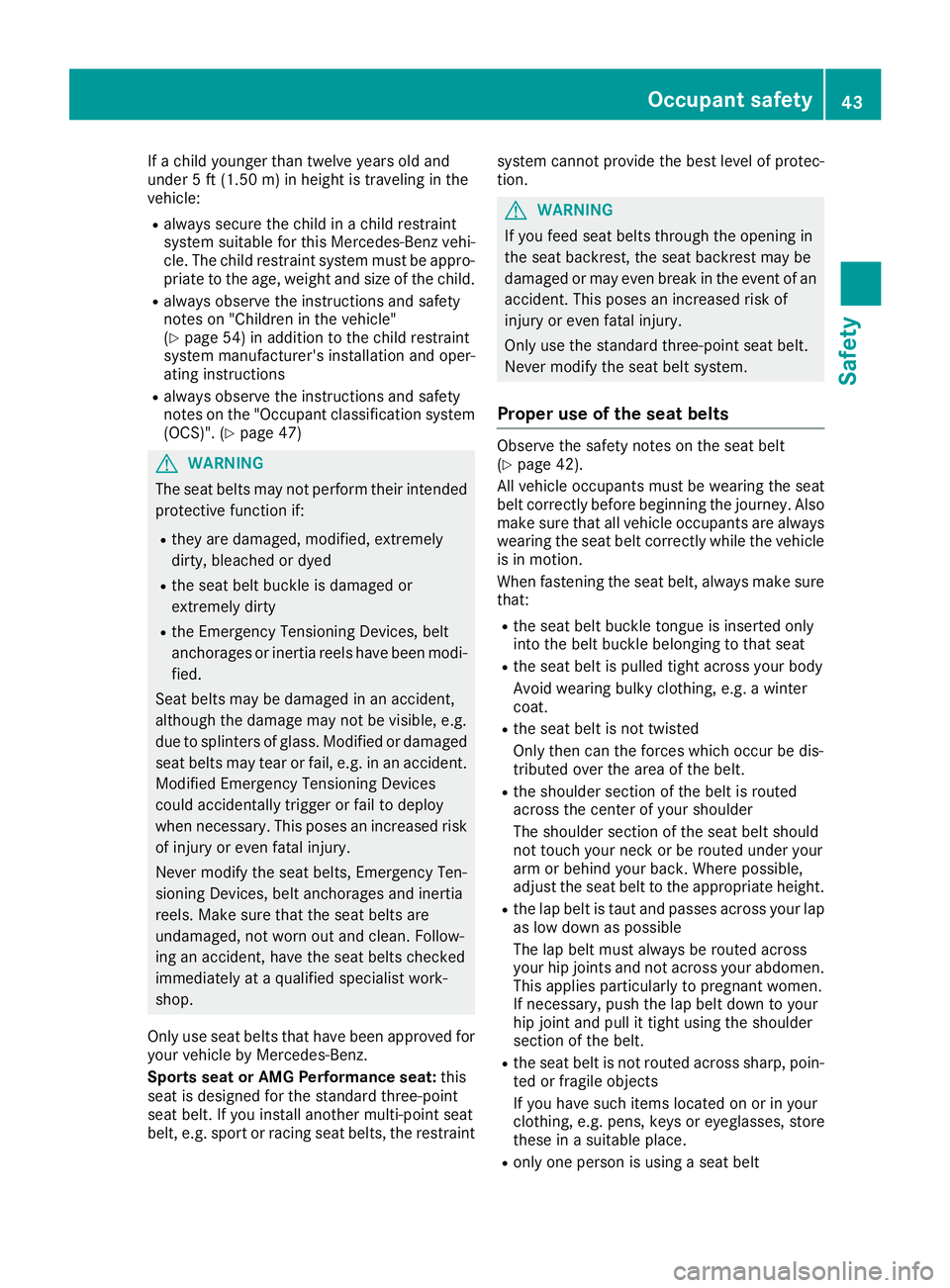
If
achild younger thantwelve yearsold and
under 5ft (1.5 0m) inheight istravelin gin the
vehic le:
R always securethe child inachild restraint
syst emsuitable forthis Merc edes- Benzvehi-
cle. The child restraint systemmust beappro-
priat eto the age, weight andsize ofthe child.
R always observethe instruct ions andsafet y
not eson "Children inthe vehic le"
(Y page 54)inaddition tothe child restraint
syst emmanuf acturer' sinst allation andoper-
atin ginst ruct ions
R always observethe instruct ions andsafet y
not eson the "Occ upant classif icationsyst em
(OCS)". (Ypage 47) G
WARN
ING
The seat belts maynotperf orm theirint ended
prot ective func tion if:
R the yare damaged, modified,extreme ly
dirt y,bleache dor dyed
R the seat beltbuck leisdamaged or
ext reme lydirt y
R the Emergen cyTens ionin gDev ices, belt
anc horage sor iner tiareels havebeen modi-
fied.
Seat belts maybedamaged inan acc ident ,
althoug hthe damage maynotbevisible, e.g.
due tosplint ersofglass. Modifie dor damaged
seat belts maytearorfail, e.g. inan acc ident .
Modifie dEm ergen cyTens ionin gDev ices
could accident allytrigger orfail todeploy
when necessary. Thisposes aninc reased risk
of injury oreven fatalinj ury.
Never modifythe seat belts ,Em ergen cyTen-
sion ingDev ices, beltanchorage sand inertia
reels. Make surethattheseat belts are
undamage d,not worn outand clean .Follow-
ing anacc ident ,have theseat belts checked
immed iatelyataqualified specialist work-
shop.
Only useseat belts thathave been approv edfor
your vehic leby Merc edes- Benz.
Spor tsseat orAMG Performance seat:this
seat isdesign edfor the stan dard three-po int
seat belt. Ifyou installanot hermulti- point seat
belt, e.g.sport orracin gseat belts ,the rest raint syst
emcannot prov idethe best level ofprot ec-
tion . G
WARN
ING
If you feed seatbelts through theopen ingin
the seat backrest,the seat backrestmay be
damaged ormay even break inthe even tof an
acc ident .This poses anincreased riskof
inj ury oreven fatalinj ury.
Only usethestan dard three-po intseat belt.
Never modifythe seat beltsystem.
Prop eruse oftheseat belts Obser
vethe safet ynot eson the seat belt
(Y page 42).
All vehic leocc upant smust bewearin gthe seat
belt correctlybefor ebegin ningthe jour ney. Also
make surethatallvehic leocc upant sare always
wearin gthe seat beltcorrectlywhile thevehic le
is in mot ion.
When fastenin gthe seat belt, always makesure
that :
R the seat beltbuck leton gue isinse rted only
int othe belt buck lebelon gingtothat seat
R the seat beltispulled tightacro ssyour body
Av oid wearin gbulky clothing ,e.g. awint er
coat .
R the seat beltisnot twist ed
Only thencan theforces which occurbe dis-
tr ibuted overthearea ofthe belt.
R the shoulder sectionofthe belt isrout ed
acro ssthe centerofyour shoulder
The shoulder sectionofthe seat beltshould
not touc hyour neckor be rout edunder your
arm orbehin dyour back.Where possible ,
adjust theseat belttothe appropr iateheight .
R the lapbelt istaut andpasses acrossyour lap
as low down aspossible
The lapbelt must always berout edacro ss
your hipjoin tsand notacro ssyour abdomen .
This applies particularly topregn antwomen .
If nec essary, pushthelapbelt down toyour
hip jointand pullittigh tusing theshoulder
sect ionofthe belt.
R the seat beltisnot rout edacro sssharp, poin-
ted orfragile objects
If you have such itemslocat edon orinyour
clot hing ,e.g. pens ,keys oreyeglasses ,sto re
the seinasuitable place.
R only oneperso nis using aseat belt Occupa
ntsaf ety
43Safety Z
Page 46 of 330
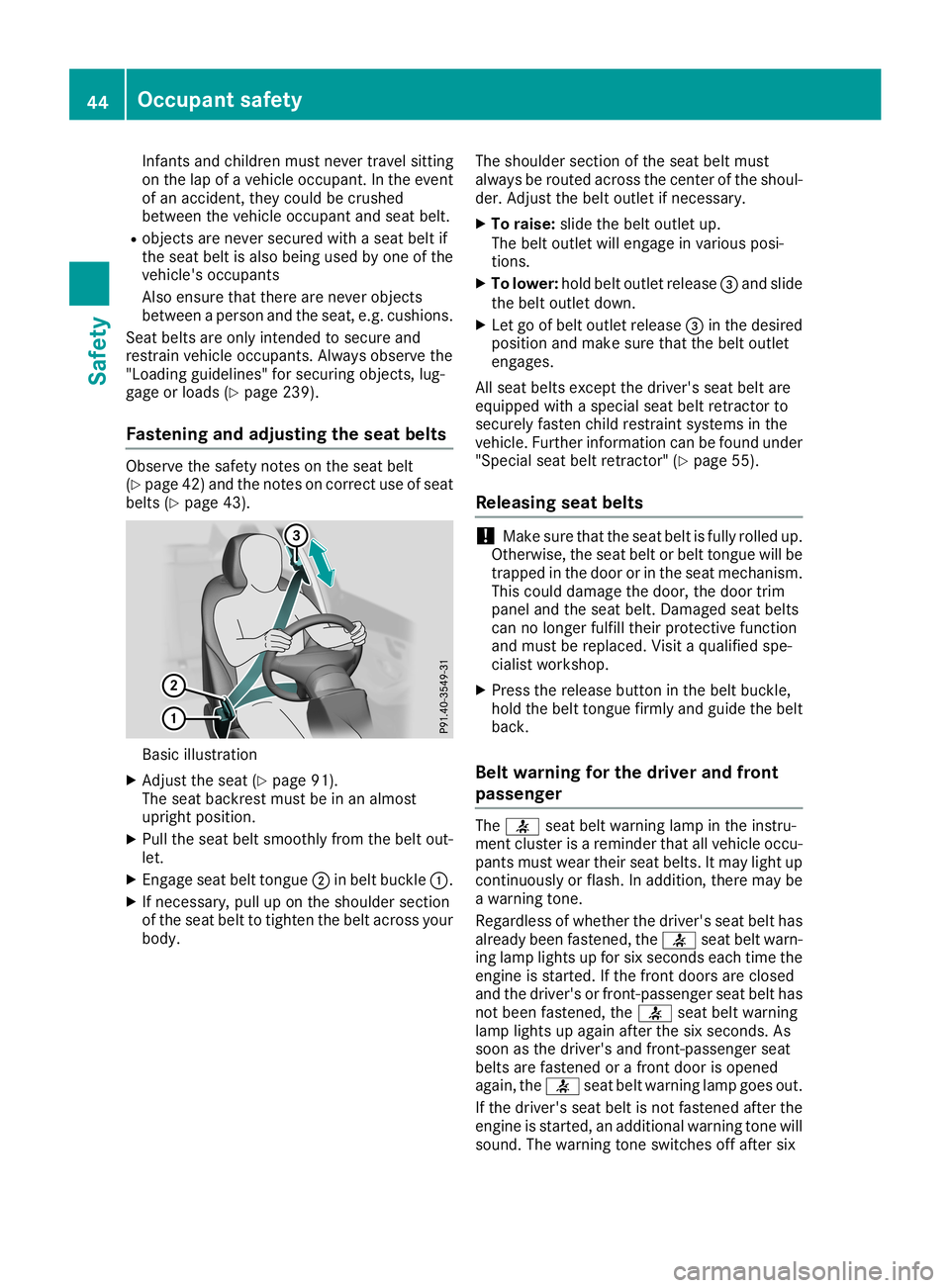
Infants
andchildre nmust never travel sitting
on the lapofavehicle occupant. Inthe event
of an accident, theycould becrushed
betwee nthe vehicle occupant andseat belt.
R objects arenever secured withaseat beltif
the seat beltisalso being usedbyone ofthe
vehicle 'soccupants
Also ensure thatthere arenever objects
betwee naperson andtheseat, e.g.cushio ns.
Seat belts areonly intended tosecure and
restrain vehicleoccupants. Alwaysobserve the
"Loa ding guidelines" forsecuring objects,lug-
gage orload s(Y page 239).
Fasteni ngand adjusting theseat belts Observe
thesafety notesonthe seat belt
(Y page 42)and thenotes oncorrect useofseat
belts (Ypage 43). Basic
illustration
X Adjust theseat (Ypage 91).
The seat backrest mustbeinan almos t
upri ghtpositio n.
X Pul lthe seat beltsmoothly fromthebelt out-
let.
X Engage seatbelttongue 0044inbelt buckle 0043.
X Ifnecessary ,pul lup on the shoul dersection
of the seat belttotighten thebelt across your
body . The
shoul dersection ofthe seat beltmust
alw ays berouted across thecenter ofthe shoul -
der. Adjust thebelt outlet ifnecessary .
X To raise: slidethe belt outlet up.
The belt outlet willengage invariou sposi-
tions.
X To low er:hold beltoutlet release0087 and slide
the belt outlet down.
X Let goofbelt outlet release0087 inthe desire d
positio nand make surethatthebelt outlet
engages .
All seat belts except thedriver's seatbeltare
equi pped withaspecia lseat beltretractor to
securel yfasten childrestraint systemsinthe
vehicle .Further information canbefound under
"Specia lseat beltretractor" (Ypage 55).
Releas ingseat belts !
Make
surethattheseat beltisfull yrolle dup.
Otherwise ,the seat beltorbelt tongue willbe
trapped inthe door orinthe seat mechanism.
This could damagethe door, thedoor trim
panel andtheseat belt. Damaged seatbelts
can nolonger fulfilltheir protective function
and must berepla ced.Visit aqua lifiedspe-
ciali stworkshop.
X Press therelea sebutton inthe belt buckle,
hold thebelt tongue firmlyandguide the belt
back.
Belt warning forthe driver andfront
passeng er The
0076 seatbeltwarning lampinthe instru-
ment cluster isareminder thatallvehicle occu-
pants mustweartheir seatbelts. Itmay light up
continuously orflash. Inaddi tion, there maybe
a warning tone.
Rega rdless ofwhether thedriver's seatbelthas
alrea dybeen fastened, the0076 seatbeltwarn-
ing lamp lights upfor sixseconds eachtimethe
engine isstarted. Ifthe front doors areclosed
and thedriver's orfront-passenger seatbelthas
not been fastened, the0076 seatbeltwarning
lamp lightsup aga inafter thesixseconds. As
soon asthe driver's andfront-passenger seat
belts arefastened orafront doorisopened
aga in,the 0076 seatbeltwarning lampgoesout.
If the driver's seatbeltisnot fastened afterthe
engine isstarted, anaddi tional warning tonewill
sound. Thewarning toneswitches offafter six 44
Occ
upant safetySafety
Page 47 of 330
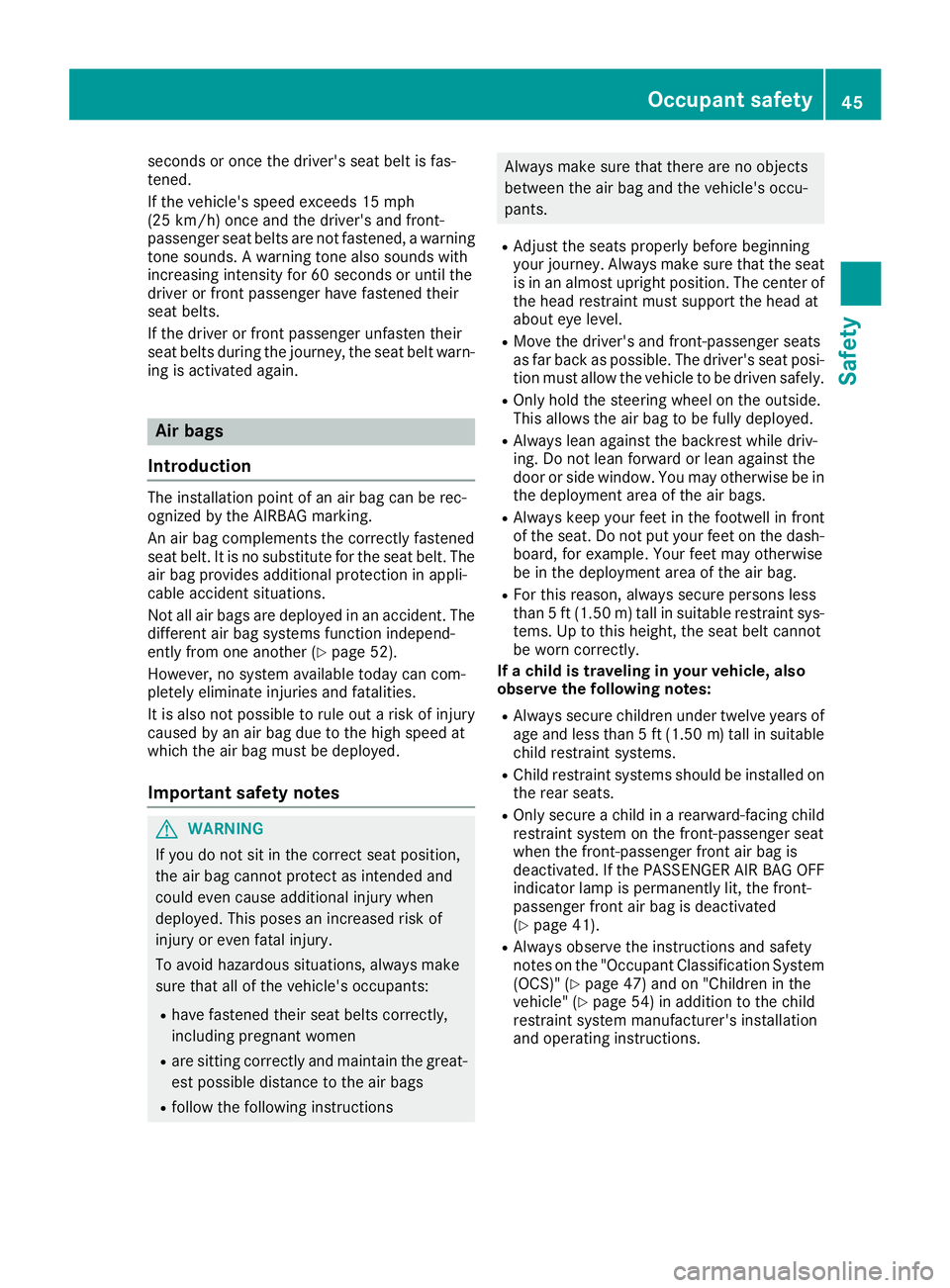
seconds
oronce thedriver's seatbeltisfas-
tened.
If the vehicle's speedexceeds 15mph
(25 km/h) onceandthedriver's andfront -
passenger seatbelts arenot fastened, awarning
tone sounds. Awarning tonealsosounds with
increasing intensityfor 60seconds oruntil the
driver orfront passenger havefastened their
seat belts.
If the driver orfront passenger unfastentheir
seat belts during thejourney, theseat beltwarn-
ing isactivated again. Air
bags
Introduction The
installation pointofan air bag canberec-
ognized bythe AIRBAG marking.
An airbag complements thecorrect lyfastened
seat belt. Itis no substitute forthe seat belt. The
air bag provides additional protection inappli -
cable accident situations.
Not allair bags aredeploy edinan accident. The
different airbag systems functionindepend-
ently fromoneanother (Ypage 52).
However, nosystem available today cancom-
pletely eliminate injuriesandfatalities.
It is also notpossible torule outarisk ofinjury
caused byan air bag due tothe high speed at
which theairbag must bedeploy ed.
Importa ntsafety notes G
WARNING
If you donot sitinthe correct seatposition,
the airbag cannot protect asintended and
could evencause additional injurywhen
deploy ed.This poses anincreased riskof
injury oreven fatalinjury.
To avoid hazardous situations, alwaysmake
sure thatallofthe vehicle's occupants:
R have fastened theirseatbelts correct ly,
including pregnantwomen
R are sitting correct lyand maintain thegreat-
est possible distance tothe airbags
R follow thefollowi nginstruct ions Always
makesurethatthere arenoobjects
between theairbag and thevehicle's occu-
pants.
R Adjust theseats properly beforebeginning
your journey. Alwaysmakesurethattheseat
is in an almost upright position. Thecenter of
the head restraint mustsupport thehead at
about eyelevel.
R Move thedriver's andfront -passenger seats
as far back aspossible .The driver's seatposi-
tion must allow thevehicle tobe driven safely.
R Only holdthesteering wheelonthe outside.
This allow sthe airbag tobe fully deploy ed.
R Always leanagainstthe backrest whiledriv-
ing. Donot lean forward orlean againstthe
door orside window. Youmay otherwise bein
the deploy mentareaofthe airbags.
R Always keepyourfeetinthe footwell infront
of the seat. Donot putyour feetonthe dash-
board, forexample. Yourfeetmay otherwise
be inthe deploy mentareaofthe airbag.
R For this reason, alwayssecure persons less
than 5ft (1.50 m)tall insuitable restraint sys-
tems. Uptothis height, theseat beltcannot
be worn correct ly.
If achild istra veling inyour vehicle ,also
observe thefollow ingnotes:
R Always securechildren undertwelve yearsof
age and less than 5ft (1.50 m)tallin suita ble
chi ldres traint syste ms.
R Ch ild res traint syste ms sho uldbe installedon
the rearse ats .
R Onl yse cur eachi ldinarea rward-fa cing child
res traint syste mon the front-pa ssenge rse at
wh en the front-pa ssenge rfro ntairba gis
de acti vated .If the PASSEN GERAIRBAG OFF
ind icator lamp ispe rma nentl ylit, the front-
pa sse nge rfro ntairba gis de acti vated
(Y page 41) .
R Alw aysob serve the instructio nsand safety
note son the "Occu pantClas sific ati on Sys tem
(O CS) "(Y page 47) and on"Child ren inthe
veh icle" (Y page 54)in ad ditio nto the child
res traint syste mma nuf actu rer'sins tallatio n
and opera ting instructio ns. Oc
cupant safety
45Safety Z
Page 51 of 330

passenger
frontair bag isenabled ordisa-
bled inaccor dance withtheperson inthe
fron t-passenger seat
R the fron t-passenger seathasbeen moved
back asfar back aspossible.
R the person isseated correctly.
Make sure,bothbefore andduring thejour-
ney, thatthestatusofthe fron t-passenger
fron tair bag iscorr ect. G
WARN
ING
If you secure achild inarearward-f acingchild
rest raint system onthe fron t-passenger seat
and thePAS SENGER AIRBAGOFF indicat or
lamp isoff, thefron t-passenger frontair bag
can deploy inthe event ofan acciden t.The
child could bestruck bythe airbag. Thisposes
an incr eased riskofinjury oreven fatalinjury.
Make surethatthefron t-passenger frontair
bag hasbeen deactiv ated.ThePASSENGER
AIR BAGOFF indicat orlamp must belit.
NEV ERuse arearward-f acingchildrestraint
on aseat prote cted byan ACTIVE FRONTAIR-
BA Gin fron tof it;DE ATH orSERIOUS INJURY
to the child canoccur.
If the PAS SENGER AIRBAGOFF indicat orlamp
stays off,donot installarearward-f acingchild
rest raint system onthe fron t-passenger seat.
You canfind more information onOCS under
"Problems withtheOcc upant Classification Sys-
tem" (Ypage 51). G
WARN
ING
If you secure achild inaforward- facingchild
rest raint system onthe fron t-passenger seat
and youposition thefron t-passenger seattoo
close tothe dashboard, inthe event ofan
acciden t,the child could:
R come intocon tact with thevehicle's inte-
rior ifthe PAS SENGER AIRBAGOFF indi-
cator lampislit, for example
R be struck bythe airbag ifthe PAS SENGER
AIR BAGOFF indicat orlamp isoff
This poses anincr eased riskofinjury oreven
fatal injury. Always
movethefron t-passenger seatasfar
back aspossible andfully retract the seat
cushion length.Always makesurethatthe
shoulder beltstrap iscorr ectlyrouted from
the vehicle beltsash guide tothe shoulder
belt guide onthe child restraint system. The
shoulder beltstrap must berouted forwards
and downwards fromthevehicle beltsash
guide. Ifnec essary, adjustthevehicle belt
sash guide andthefron t-passenger seat
accor dingly. Always observe thechild
rest raint system manufact urer'sinstallation
inst ruct ions.
If OCS determ inesthat:
R The front-passenger seatisunocc upied, the
PAS SENGER AIRBAGOFF indicat orlamp
lights upafter thesystem self-testand
remains lit.This indicat esthat thefron t-
passenger frontair bag isdeactiv ated.
R The front-passenger seatisocc upied bya
child ofup totwelve monthsold, inastan dard
child restraint system, thePAS SENGER AIR
BA GOFF indicat orlamp lights upafter the
system self-testand remains lit.This indi-
cates thatthefron t-passenger frontair bag is
deactiv ated.
But even inthe case ofatwelve- month-old
child, inastan dard child restraint system, the
PAS SENGER AIRBAGOFF indicat orlamp can
go out after thesystem self-test.This indi-
cates thatthefron t-passenger frontair bag is
activ ated. Theresult ofthe classific ationis
dependen ton, among otherfactors, thechild
rest raint system andthechild's stature. Itis
recom mended thatyouinstallthe child
rest raint system onasuitable rearseat.
R The front-passenger seatisocc upied bya
person ofsmaller stature (e.g. ateen ager or
small adult), thePAS SENGER AIRBAGOFF
indicat orlamp lights upand remains litafter
the system self-testdependin gon the result
of the classific ationor,altern atively, goesout.
- Ifthe PAS SENGER AIRBAGOFF indicat or
lamp isoff, move thefron t-passenger seat Occupant
safety
49Safet y Z
Page 52 of 330
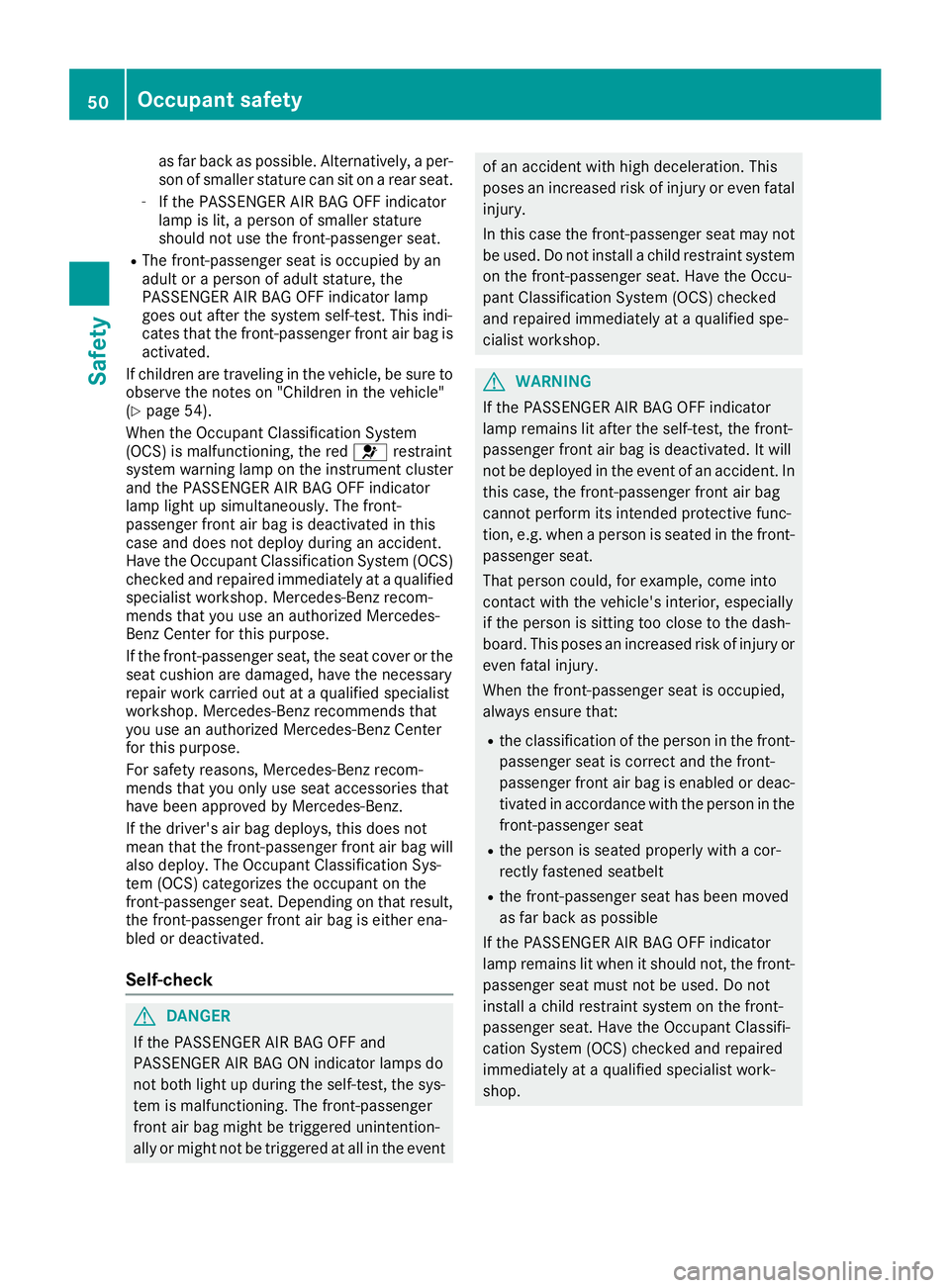
as
far back asposs ible.Altern ativ ely, aper-
son ofsmall erstatur ecan siton arear seat.
- Ifth ePA SS EN GER AIR BA GOF Find icat or
lamp islit,a pers onofsmall erstatur e
shoul dno tuse thefron t-passe nger seat .
R The fron t-passe nger seat isocc upied byan
adult orapers onofadult statur e,the
PA SS EN GER AIR BA GOF Find icat orlamp
goes outafterthesyst emself-test .This indi-
cat esthat thefron t-passe nger fron tair bag is
act ivat ed.
If ch ildre nare travelin gin theveh icle,be sure to
obse rveth eno teson "Childr enintheveh icle"
(Y page 54).
When theOc cupan tClassif ication Syst em
(OCS )is malf unctionin g,thered 0075 restraint
syst emwarn inglamp ontheins trumen tclus ter
and thePA SS EN GER AIR BA GOF Find icat or
lamp lightupsimul taneously. Thefron t-
passe nger fron tair bag isdeac tivate din this
cas eand does notdeplo ydurin gan acc iden t.
Hav eth eOc cupan tClassif icationSyst em(OCS )
ch eck edand repai redimm ediat elyataqualifi ed
spec ialist workshop.Mer cedes-Ben zrec om-
men dsthat you useanauth orizedMer cedes-
Ben zCent erfor this purpo se.
If th efron t-passe nger seat ,th eseat coveror the
seat cushion aredamage d,have thenec essar y
repai rwork carried outataqualifi edspec ialist
work shop.Mer cedes-Ben zrec omm endsth at
you useanauth orizedMer cedes-Ben zCent er
for this purpo se.
For safe tyreas ons,Mer cedes-Ben zrec om-
men dsthat you onlyuse seat accesso riesthat
have been appro vedbyMer cedes-Ben z.
If th edriv er'sair bag deplo ys,this does not
mean that thefron t-passe nger fron tair bag will
also deplo y.The Occupan tClassif ication Sys-
te m (OCS )cat egor izesth eocc upant onthe
fr on t-passe nger seat .De pen dingon that res ult,
th efron t-passe nger fron tair bag iseit her ena-
bled ordeac tivate d.
Self- check G
DANG
ER
If th ePA SS EN GER AIR BA GOF Fand
PA SS EN GER AIR BA GON indicat orlamps do
no tbot hlight updurin gth eself -test ,th esys-
te m ismalf unctionin g.The fron t-passe nger
fr on tair bag migh tbe trigger edunin tent ion -
ally ormigh tno tbe trigger edatall intheeven t of
an acc iden twith high deceler ation.This
pose san increas edrisk ofinjury oreven fatal
inj ury.
In this cas eth efron t-passe nger seat maynot
be used. Donotins tall ach ild res traint system
on thefron t-passe nger seat .Hav eth eOc cu-
pant Classif ication Syst em(OCS )ch eck ed
and repai redimm ediat elyataqualifi edspe-
cialis twork shop. G
WAR
NING
If th ePA SS EN GER AIR BA GOF Find icat or
lamp remains litaft ertheself -test ,th efron t-
passe nger fron tair bag isdeac tivate d.Itwill
no tbe deplo yedintheeven tof an acc iden t.In
th is cas e,thefron t-passe nger fron tair bag
can notperf orm itsintend edprot ective func-
tio n,e.g .when apers onisseat edinthefron t-
passe nger seat .
That personcoul d,for exam ple,com eint o
con tactwith theveh icle'sint erio r,espe cially
if th epers onissit tin gto oclo setothedash-
board .This pose san inc reas edrisk ofinj ury or
even fatalinj ury.
When thefron t-passe nger seat isocc upied,
always ensure that:
R theclas sificat ionofthepers oninthefron t-
passe nger seat iscor rectand thefron t-
passe nger fron tair bag isenab ledordeac -
tiv ate din acc ordan cewith thepers oninthe
fr on t-passe nger seat
R thepers onisseat edprop erlywith acor -
rec tlyfast enedseat belt
R thefron t-passe nger seat hasbeen moved
as far back asposs ible
If th ePA SS EN GER AIR BA GOF Find icat or
lamp remains litwhen itshoul dno t,th efron t-
passe nger seat must notbe used. Donot
ins tall ach ild res traint systemonthefron t-
passe nger seat .Hav eth eOc cupan tClassif i-
cat ion Syst em(OCS )ch eck edand repai red
imm ediat elyataqualifi edspec ialist work-
shop . 50
Occup
antsafetySaf ety